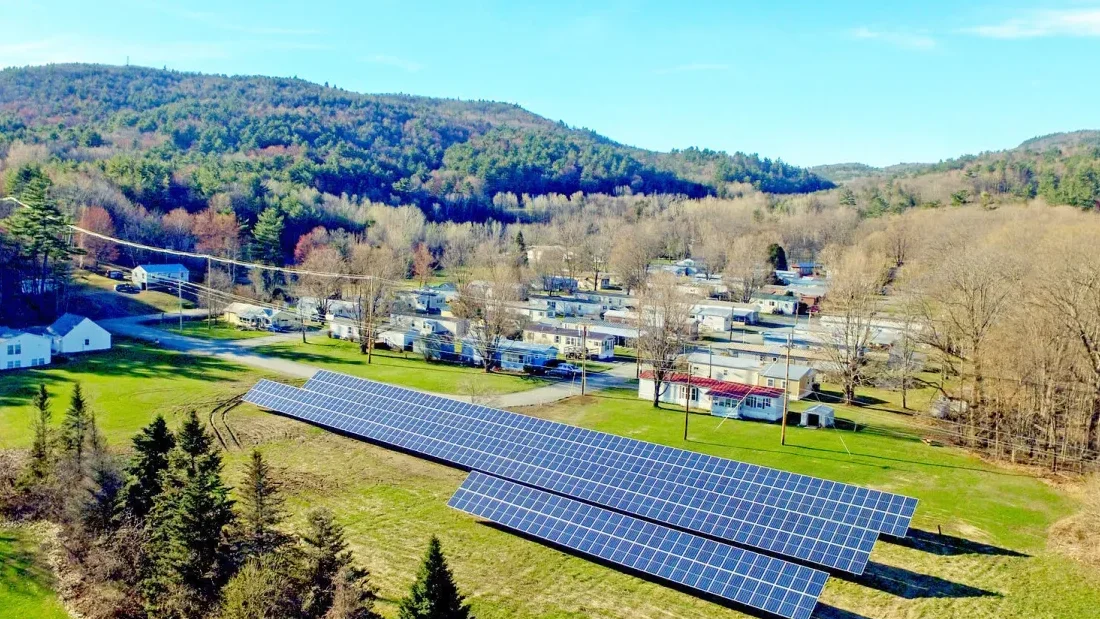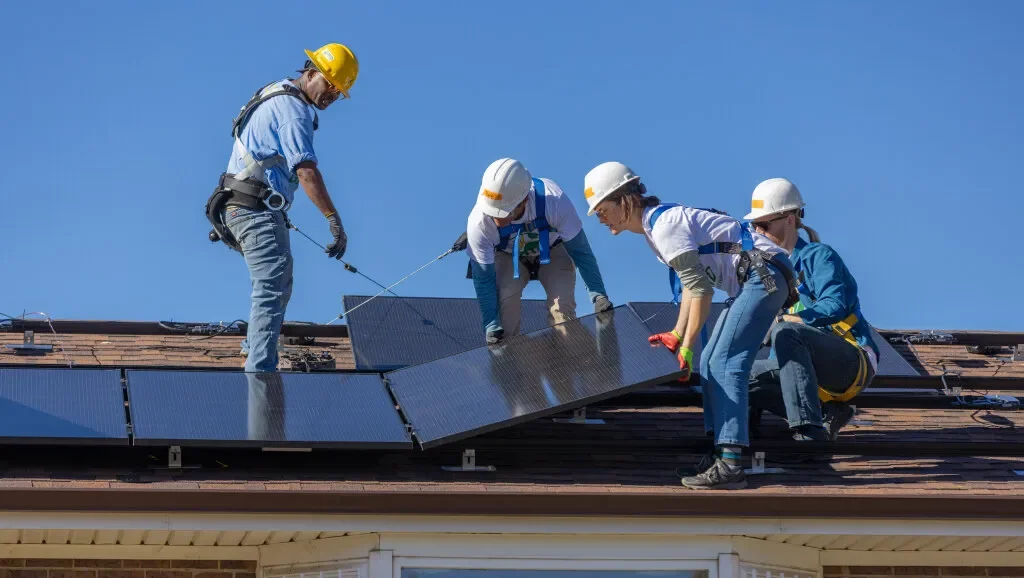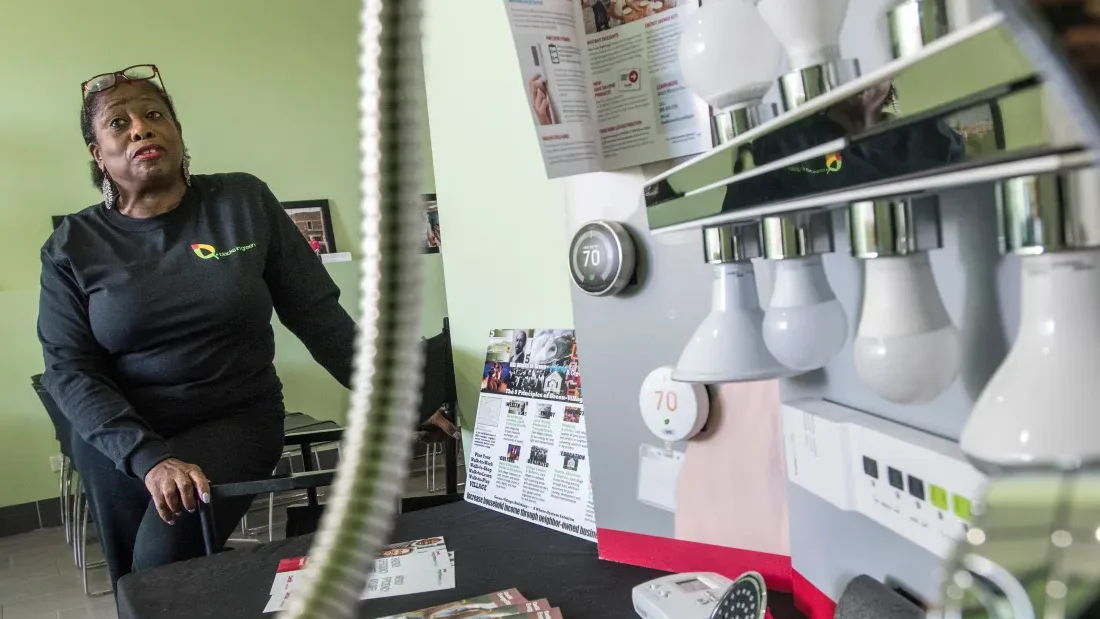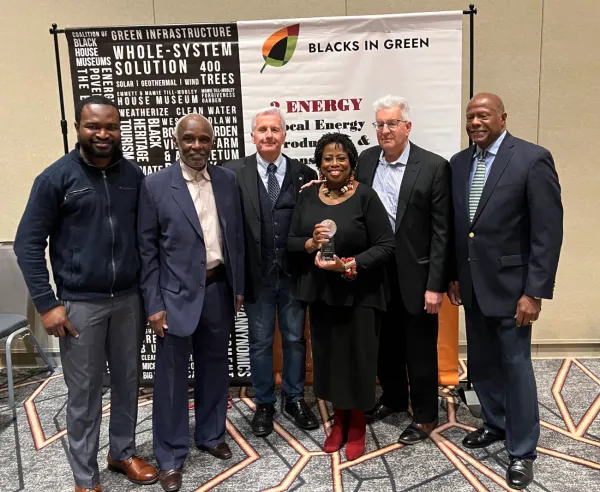
CLEAN ENERGY: A coalition of regional groups uses a $10 million federal grant to recruit more than 1,000 small and medium manufacturers for the growing clean energy economy in West Virginia and four other Appalachian states. (Energy News Network)
ALSO:
CARBON CAPTURE: The U.S. EPA grants Louisiana the authority to approve and regulate the drilling of wells for carbon capture projects. (Louisiana Illuminator)
SOLAR: Solar advocates in Georgia and elsewhere embrace federal funding for programs to reduce energy bills by making solar power affordable for lower-income households. (WABE/Grist)
ELECTRIC VEHICLES:
WIND: A Virginia city receives more than $39.2 million to renovate a marine terminal into an offshore wind logistics facility. (WVEC)
HYDROGEN:
GRID:
POLITICS: Virginia environmental justice advocates worry Republican Gov. Glenn Youngkin is hampering a 2020 law intended to boost transparency and engagement with communities affected by pipelines and other energy projects. (Inside Climate News)
OVERSIGHT:
COAL:
UTILITIES: West Virginia water and gas utilities spat over a line break and service outage last month. (Charleston Gazette-Mail)

As federal incentives spur a wave of new domestic clean energy manufacturing, economic boosters in Ohio and neighboring states see an opportunity to “Make it in Appalachia.”
A virtual summit this month will serve as part of public kickoff efforts to identify and support small and medium manufacturers in the region so they can play a role in the growing clean energy economy.
The New Energy Economy project is being funded by a $10 million federal grant awarded this fall. Lead applicant Catalyst Connection and ten other partners have been working over the past two months to finalize subcontracts for the effort, which encompasses 156 counties in Ohio, Pennsylvania, West Virginia, Maryland and New York.
“By supporting small-to-medium manufacturers and providing training and resources, we can drive economic transformation, create in-demand jobs, and build a brighter future for Appalachian communities,” said Steve Herzenberg, co-director of ReImagine Appalachia, one of the grant partners.
ReImagine Appalachia is hosting its virtual strategy summit on January 16 and 17. The first day will focus on how to turn the Ohio River Valley into a sustainable manufacturing hub, with discussions the next day focused on community rebuilding and workforce development under federal climate infrastructure programs.
The Appalachian Regional Commission is providing funding for the grant under the federal Bipartisan Infrastructure Law as part of its Appalachian Regional Initiative for Stronger Economies. ARISE supports multi-state projects to drive large-scale regional economic change.
The New Energy Economy project will provide training, technical assistance, supply chain mapping and guidance for factory and product upgrades to more than 1,000 small to medium-sized manufacturers over four years in sectors that include renewable energy, hydrogen, smart grid, green buildings, and electric vehicles.
“We want to identify and support companies that want to participate in a new clean energy supply chain or improve their factory in energy efficiency,” said Petra Mitchell, president and CEO at Catalyst Connection, based in Pittsburgh. Although much of Appalachia is rural, the region includes many towns and cities.
Mitchell said a wide range of businesses could benefit in different sectors. Planned hydrogen hubs, for example, will need lots of metal products and meters, she said. So companies making those types of things may want to think about how they could adapt existing products or develop new ones to serve that sector.
Similarly, lots of pieces and parts go into wind turbines, said Amanda Woodrum, another co-director of ReImagine Appalachia. “They’re made of things that we make already, like gearboxes and bearings.” The grant project can help identify companies that might be a good fit for making those things and provide technical know-how so they can gear up to expand.
Yet there are barriers to getting into new markets.
“Across the region, many small and medium-sized manufacturers lack the capabilities to participate in the supply chains for green energy production or green products manufacturing,” said Janiene Bohannon, communications director for the Appalachian Regional Commission. “Appalachian manufacturers and energy providers seeking to pivot to greener models face difficulties in post-COVID supply chain disruptions, labor shortages, increasingly dated facilities and technology, and lack of availability of training in said technology.”
Large manufacturers often have staff or can afford consultants to grow their businesses and navigate entry into new market sectors.
“Small companies rarely do this,” said Ethan Karp, president and CEO of MAGNET in Cleveland.
The nonprofit will be responsible for providing roughly $1 million in services to companies in Ohio counties covered by the grant. Other manufacturing extension partners will work with companies in the four other states covered by the grant.
More than half of the 32 Ohio counties rank among the 25% most economically depressed counties nationwide. Only two are “competitive” under the commission’s designation system.
“We can really make a difference there,” Karp said. “We’re going to retain a ton of jobs, and we’re going to strengthen the output and grow our communities.”
Work in the manufacturing sector generally pays better than low-wage jobs that have employed many people in Appalachia after other manufacturing jobs left the area and the coal industry declined over the past several decades. A significant number of people in Appalachia have also become disconnected from the workforce, Woodrum said.
Now, across the five states included in the grant, the project is expected to serve 1,100 businesses, create 5,500 jobs, retain 15,190 jobs and provide $44 million worth of cost cuts, Bohanon said.
“We already have a presence in these counties,” Karp said, adding that MAGNET has already done some work helping manufacturers find opportunities for energy efficiency. MAGNET provides its educational and consulting services free of charge. Companies then invest in projects that can save money or otherwise boost their profit margins.
Lots more outreach about the grant program will follow after the upcoming strategy session for ReImagine Appalachia. Among other things, that outreach will help companies in the region think about whether they can play a role in the clean energy supply chain, even if that role isn’t initially obvious.
“It doesn’t have to necessarily be high-tech stuff,” Karp said, adding that a lot of the shift will be market driven. So, as more electric vehicles come on the market, companies will want to think about how they can be part of that growth. Or, as there’s more electrification, manufacturers may want to think about products they could supply. And then companies will need more training and technical help to expand their businesses through capital investments, any workforce issues and more.
“With the right sustainable strategy and the right investments, we can actually turn the region into leaders in the new energy economy,” Woodrum said. “The kind of manufacturing and the jobs that it creates are a big important piece of that puzzle.”
Historically, “Appalachia’s been one of the most likely places for innovation,” said Rick Stockburger, president and CEO of BRITE Energy Innovators, based in Warren, Ohio, which is not part of the Catalyst Connection grant project. “There’s no structural reason why it can’t be again, especially as we’re thinking about this new economy and how we make sure everybody can participate in it.”

STORAGE: Analysts predict the federal climate package will drive a record-breaking year for battery installations, with Texas and California continuing to lead the industry’s growth. (S&P Global)
TRANSPORTATION:
OIL & GAS:
SOLAR: A federal program meant to expand low-income community solar may face challenges verifying income and building trust in communities that have largely been left out of the clean energy transition. (Energy News Network)
BUILDINGS:
WIND: The offshore wind industry looks to rebound in 2024 after a year of canceled contracts and missed launch dates. (E&E News)
GRID: The U.S. Department of Energy will release up to $70 million for public and private entities, universities and national laboratories to advance grid security and resilience research. (Utility Dive)
CLIMATE:
COAL ASH: The U.S. EPA’s assessment of coal ash as more carcinogenic than previously realized could shift North Carolina’s plans to clean up the substance in Chapel Hill and at least 70 other sites around the state. (NC Newsline)

Communities in southern Maine are collaborating on a pilot program that aims to help residents overcome cost and logistical barriers to accessing climate-friendly home energy upgrades.
Five towns and two regional nonprofits received a three-year, $800,000 grant from the U.S. Department of Energy’s Energy Efficiency and Conservation Block Grant Program in late 2023. The budget for the program is now being finalized for launch this summer or fall.
The grant will fund AmeriCorps members to provide one-on-one energy coaching for residents. These “navigators” will help identify the best cost- and emissions-cutting retrofits for each home, and will help residents apply for a range of accompanying tax credits, rebates and other incentives. The grant also includes about $500,000 to directly offset residents’ remaining costs.
“The pilot program, as we envision it, will remove the up-front capital barrier and help homeowners navigate the process with confidence,” said Kendra Amal, the town manager in Kittery, one of the towns participating in the grant. “We expect to see a significant increase in the number of households able to make energy-reducing and cost-saving improvements to their homes through this program.”
Kittery joins the towns of Kennebunk, Kennebunkport, Wells and Ogunquit in working with Southern Maine Planning and Development Commission on the project, along with York County Community Action Corporation. SMPDC will host the AmeriCorps navigators, while the county action agency will set up a new Southern Maine Energy Fund to help pay for projects and will provide energy services staffers to oversee actual retrofits and installations.
“We’ve heard from all of our communities that home weatherization and heat pumps are really important, but they didn’t feel like they could do it themselves,” said SMPDC sustainability coordinator Karina Graeter. “(This program) provides the opportunity for these smaller communities that don’t have their own sustainability staff or their own capacity to undertake big outreach and education efforts … to try and address the energy issues that have been shown to be really important to the community.”
Maine relies more on home heating oil than any other state, and residential emissions are the state’s top contributor to climate change after transportation. In recent years, Maine has been nationally lauded for successful efforts to incentivize efficient electric heat pumps as a replacement for oil. State heat pump and weatherization rebates can total thousands of dollars per project, especially for lower-income people, and federal tax credits can offer thousands more.
But even hefty incentives may not cover everything, and energy bill savings from these upgrades can take months or years to materialize — meaning many people still can’t afford remaining project costs, said Amal and Graeter.
During Kittery’s climate action planning process, the town discovered that many residents weren’t taking advantage of state energy rebates, Amal said. And costs were not the only problem; Amal said residents also cited “the confusing and often rigid process required to qualify” for incentives as another reason they chose not to pursue home efficiency or electrification work.
“There are so many great incentives out there, but they’re always sort of changing depending on what funding is available, you know, who’s running the program,” said Graeter. “Helping people navigate that requires a certain amount of skill and knowledge.”
The program’s navigators will be trained to help residents make the most of these complex offerings, she said.
The grant proposal envisions connecting with interested residents through whatever way they reach out to a participating group, whether it’s via the county agency or a town. Residents of any income would be paired with a navigator, who would answer their questions, assess their needs and provide technical assistance on designing a project with the greatest energy savings impact.
For low- and moderate-income families, the program would also provide instant rebates to offset upfront project costs. The county agency’s energy technicians would do the actual installation work on the project and follow up on other assistance options, including tax credits as needed.
In the next six months of setting up the program, Graeter said her cohort plans to seek inspiration from other regional groups — like the county agency partnering on the grant, or WindowDressers, which builds heat-saving window inserts for low-income people — to design a community engagement approach that will reach the most people.
“The idea is to have a ‘no wrong path’ sort of option for people; meeting people where they’re at in terms of their energy needs, and figuring out what assistance they need most,” she said.
The participating towns have been working toward this program for years, since initially collaborating to fund Graeter’s position at SMPDC, Graeter said. This regional approach lets them learn from each other and build on shared progress rather than duplicating effort, she said.
Amal noted that the pilot nature of the program also aims to help officials evaluate impact and potentially scale up similar efforts elsewhere in the state.
Graeter stressed that the grant doesn’t seek to replace federal energy tax credits or existing state programs offered by Efficiency Maine, the quasi-governmental agency that oversees Maine’s energy incentives.
“Our focus is really to increase access to those programs, and then provide some additional financial support to help bridge the gap between current incentives and the true cost of these upgrades, which is always shifting and changing,” she said.

CLEAN ENERGY: State-level clean energy policies had a strong year in 2023 as Democrats in states like Minnesota and Michigan treated climate action like a political asset. (E&E News)
ALSO: A Minnesota agency overseeing the state’s clean energy transition adds 64 positions to its staff of roughly 90 to help manage new state energy-related programs and capitalize on federal funding opportunities. (Energy News Network)
OIL & GAS: U.S. gas utilities serving more than 35 million customers offer builders and contractors incentives to keep fossil fuels in new buildings, part of a longstanding relationship that could impede electrification. (The Guardian)
CLIMATE: Challenging previous claims of the Midwest as a climate haven, a new report says the region can expect an increase in climate abandonment, particularly from high-flooding areas, over the next 30 years. (Planet Detroit)
WIND: A Cleveland-area company aims to grow the market for its benches, picnic tables and other outdoor furniture crafted from recycled wind turbine blades. (Energy News Network)
BIOGAS: Biogas digesters are receiving a growing share of federal rural clean energy program funding coming into Wisconsin, as critics question the climate benefits of the technology. (Tone Madison)
NUCLEAR: The owner of a southwestern Michigan nuclear plant is contesting its property tax assessment which, if lowered, could cost the state and local governments millions of dollars in tax revenue. (WSJM)
WORKFORCE:
ELECTRIC VEHICLES:
SOLAR:
CLIMATE: The outgoing mayor of Des Moines, Iowa, is appointed to serve as the city’s climate ambassador after leaving office. (KCCI)
COMMENTARY: A Michigan Democratic state representative says the state’s new clean energy laws will boost grid reliability while lowering bills. (Bridge)

CLIMATE: Clean electricity standards enacted in Minnesota and Michigan bookended a year of state-level climate progress that included gas hookup restrictions and new funding for clean energy manufacturing. (E&E News)
OIL & GAS:
ELECTRIC VEHICLES:
EMISSIONS: The U.S. Supreme Court will hear a challenge to the U.S. EPA’s anti-air-pollution “good neighbor” rule that limits power plant emissions that drift into other states. (Associated Press)
WIND:
SOLAR: A California appeals court rejects a petition to overturn a new state policy cutting compensation for rooftop solar; petitioners say they may take the case to the state Supreme Court. (San Diego Union-Tribune)
UTILITIES: North Carolina regulators consider Duke Energy’s green tariff proposal, which would allow the utility to count customers’ renewable energy purchases toward compliance with its state carbon emission goals. (Energy News Network)
CLEAN ENERGY: A Minnesota agency overseeing the state’s clean energy transition adds 64 positions to its staff of roughly 90 to help manage new state programs and capitalize on federal funding opportunities. (Energy News Network)
FINANCE: Industry analysts say cleantech investing is poised for a strong 2024 after a slow start to 2023 rebounded in the second half of the year. (Canary Media)

SOLAR: A California appeals court rejects a petition to overturn a new state policy cutting compensation for rooftop solar; petitioners say they may take the case to the state Supreme Court. (San Diego Union-Tribune)
ALSO: A survey finds California’s solar industry has lost about 17,000 jobs since regulators slashed net metering rates for residential installations. (news release)
CLEAN ENERGY:
ELECTRIFICATION: A small Colorado town’s proposal to decarbonize buildings by banning natural gas hookups in new construction runs up against the nation’s largest natural gas-only utility’s opposition and political power. (NPR)
UTILITIES: Wyoming regulators approve a 5.5% Rocky Mountain Power rate hike after the utility admits its proposed 29.2% increase was partly based on a major accounting error. (WyoFile)
STORAGE: An Arizona utility brings a 100 MW battery energy storage system online in the southern part of the state. (Renewable Energy World)
TRANSITION: Northwestern New Mexico economic development officials seek $100 million in state funds to expand the fossil fuel-reliant region’s energy economy by creating a hydrogen production hub. (Farmington Daily Times)
CLIMATE:
COAL: A Utah coal mine that has been on fire since last year is “idled indefinitely” and plans to lay off its remaining 150 employees in January. (Salt Lake Tribune, subscription; Argus Media)
CARBON CAPTURE: The U.S. EPA publishes draft injection well permits for sequestering carbon dioxide from a hydrogen production facility in southern California, the agency’s first for the state. (E&E News, subscription)
HYDROPOWER: A Colorado organization acquires Colorado River water rights from an Xcel Energy hydropower plant in an innovative $100 million deal. (Aspen Journalism)
NUCLEAR: The Columbia nuclear power plant in Washington state completes its initial 40-year operating phase with plans to continue to keep operating at least until 2043. (Tri-City Herald)
OIL & GAS: Federal analysts predict natural gas prices will remain low through the winter, digging into tax revenues in gas-producing states like Wyoming. (Oil City News)
BIOFUELS: California awards $4 million to planned bioenergy facilities that will burn forest restoration waste to generate power. (Biofuels Digest)

One of the primary state agencies that oversees Minnesota’s climate and clean energy programs is expanding its staff by nearly two-thirds, fueled by new state and federal funding opportunities.
The Minnesota Department of Commerce’s Division of Energy Resources, which plays a central role in Minnesota’s clean energy transition, has added 64 positions to its roughly 90 employees at the start of the year. Of those positions, 42 have been filled and 22 are in the hiring process.
The department oversees programs related to energy conservation, solar for schools and colleges, weatherization, energy assistance and other associated areas.
The hiring spree is being paid for with new funding from state and federal legislation. The Legislature created seven new energy-related programs this spring, including rebate efforts, a $100 million state competitiveness fund and a green bank. The Division of Energy Resources will manage the new programs, which are expected to begin next year.
“We anticipate that as various programs are set up, we may need additional staffing to support those efforts,” said Michelle Gransee, a deputy commissioner who oversees the division.
Some of the new hires are already helping bring in additional federal dollars to the state. Since July, the division has secured over hundreds of millions of dollars in new funding for utilities and communities under the Inflation Reduction Act and other programs.
“Bringing in hundreds of millions, if not billions of dollars, requires dedicated staffing,” Gransee said.
Employees will fill out new and existing roles after a department restructuring that added new sections to deal with responsibilities created by lawmakers in the 2023 session, the most productive for energy legislation in Minnesota history. Other hires will assist in funding that has come through the Inflation Reduction Act and other federal laws.
The surge in new employees is the largest Gransee has seen in her 14-year Commerce career. The only comparable period came in 2009 when the American Recovery and Reinvestment Act funded money for clean energy, but that lasted just two years.
The division has been hiring program developers, economists, lawyers, engineers, building science specialists, and grants and contracts experts, to name a few.
“We’re bringing in a diversity of talent and experience, which we were thrilled to see,” Gransee said.
The division has been receiving applications from employees of other state agencies, as well as recent University of Minnesota graduates, and people with backgrounds in nonprofits, utilities, and think tanks. The state has used LinkedIn and other regional and national experts to cast a net beyond Minnesota. Many applicants, she said, have been attracted to working at Commerce because they can have a direct impact on mitigating climate change in the state.
Among the recent higher profile hires have been Pete Klein, former vice president of finance at the St. Paul Port Authority, who planned to retire before being offered the opportunity to lead the department’s Minnesota Climate Innovation Finance Authority. With a budget of $45 million, the climate innovation authority, also known as a green bank, will develop financing tools to leverage private investment.
The department also recently hired John Michael-Cross, formerly a project manager with the Washington, D.C.-based Environment and Energy Study Institute, to run the state’s community solar program. In 2023, the Legislature moved management of the program from Xcel Energy to the state division.
Gransee said not all new employees will be permanent. Several will work under contract and not become employees.
“The tradition of coming into the state and working for the next 40 years for it isn’t for everybody,” she said. “For some, it’s exciting to come into a position that’s two or three years long, have a great impact, and then see what’s next.”
The Division of Energy Resources has recently expanded with more than 30 new programs that will be managed by the following offices:
“Each of those offices has some growth in them,” she said. “Some are entire units; others will have just one additional person coming into a space for a specific project or program.”
Gregg Mast, executive director of the nonprofit Clean Energy Economy Minnesota, said the additional employees will be needed to have “rapid rollout of the new programs so we can have swift implementation.” The advocacy group hopes Commerce’s new staff members will expand private sector clean energy jobs in Minnesota.
Since the legislative session ended, Gransee said agency staff have been occupied with creating new and updating existing programs.
“We’re thrilled by the expansion,” she said. “We could have twice as many staff and still keep everybody busy.”

In the meantime, check out ten of our best Energy News Network stories from the past year, from tackling toxic coal ash in Puerto Rico to electrifying buildings in snowy Maine.
Heating and cooking aren’t the only sources of building emissions: In Massachusetts and beyond, advocates and policymakers are starting to tackle the carbon footprint of all the materials and labor that goes into new buildings.
Detroit resident ‘leads with love’ while laying a foundation for neighborhood climate resiliency: On Detroit’s east side, Tammara Howard is leading efforts to build a network of climate resilience hubs to help residents thrive amid a changing climate.
For tree-sitter, no hiding from heartbreak of deal to greenlight Mountain Valley Pipeline: The federal government’s approval of the contentious Mountain Valley Pipeline brought heartbreak for Theresa “Red” Terry and other Virginia advocates.
Who decides where we get electricity and how much we pay? Mostly White, politically connected men: A pair of studies showed how public utility commissions, which have control over electricity rates and sources, don’t look like the people they represent.
For this immigrant-led clean energy company, perspective is everything: A Chicago-area engineer and CEO with roots in Ghana, Senyo Ador and his Sẽsẽnergi Eco Solutions Enterprise is helping the next generation of energy workers find their footing.
Making Maine’s next generation of housing fossil-free — and affordable: Maine’s population is growing faster than its housing supply, and advocates say that gives the state an opportunity to build out denser, all-electric, energy efficient housing.
In Puerto Rico, residents wait for accountability, cleanup of toxic coal ash ‘caminos blancos’: Two decades after a Virginia-based power company sold toxic coal ash to Puerto Rico towns as a cheap material for road construction, residents are fighting for cleanup and accountability.
With N.C. home efficiency codes frozen, advocates eye other opportunities: After North Carolina’s building industry lobbied to stave off new energy-efficient building codes for years, advocates are looking to federal tax credits and utility incentives to clean up building emissions.
Low-emissions steelmaking could be big business for Minnesota’s Iron Range, experts say: We finished out the year with this collaboration with Minnesota’s KAXE/KBXE, diving into ways the state can clean up its emissions-heavy taconite mining industry.
🤝 COP’s big deal: The COP28 climate summit ends with the first-ever global agreement to begin “transitioning away from fossil fuels,” though some leaders acknowledge the pact is nonbinding and should’ve been reached years ago. (Politico)
🎓 America’s climate report card: Climate and clean energy experts grade U.S. climate progress in 2023, from an A- for clean energy investments to an F for its patent system that keeps critical breakthroughs private. (Grist)
🛢️ Normalizing carbon capture: The rising viability of carbon capture worries climate scientists, who say oil and gas producers could use it as a loophole to keep drilling. (E&E News)
⚡ Sidestepping gas bans: Western cities find innovative ways to push building electrification — such as setting emissions targets and restricting indoor air pollution — that don’t violate a court order prohibiting natural gas hookup bans. (Grist)
🔌 EV charging inconsistencies: Experts say the electric vehicle charger industry faces a big dilemma as it aims to normalize charging standards and software among several manufacturers. (Canary Media)
🧊 DEI efforts stall out: Efforts to diversify environmental organizations appear to have stalled or even lost ground, according to a new analysis, potentially jeopardizing the fight for equitable climate solutions. (Axios)

An effort led by Chicago’s Blacks in Green has been recommended for $12.5 million in renewable energy credits to help develop three community solar projects to benefit underresourced communities.
The three projects totaling 9 MW are valued at $25.7 million and will be developed by the Green Energy Justice Cooperative, a project launched by Blacks in Green and other partners, to benefit Black, Brown and low and moderate-income subscribers in and around Aurora, Naperville, and Romeoville, Illinois. The Illinois Power Agency ranked the projects first, second and fourth among proposals vying for renewable energy credits in the Illinois Shines competition.
Naomi Davis, founder and CEO of Blacks in Green, says the recognition is the culmination of a long effort to ensure energy independence for her community.
“The importance of the industry was made very, very clear to me and others right from the start,” she said. “The opportunity was presenting itself with renewable energy credits that Blacks in Green and others had fought for, for over a decade to really build out the toolkit for the renewable energy industry in Illinois.”
“We’re delighted to partner with Blacks in Green to help create new sources of renewable energy in Aurora and Romeoville through the Green Energy Justice Co-op,” said Vibhu Kaushik, senior vice president and global head of energy, utilities, and storage at Prologis in a news release. “As a member of the local business community, Prologis is focused on working with our customers, local governments, and local partners like Blacks in Green to help create a vibrant and sustainable economy.”
Launched in 2022, the Green Energy Justice Cooperative, or GEJC, strives to provide low-income communities of color with the economic and political power of owning energy generation. It coordinates the efforts of organizations that have been working toward economically and racially just ownership of local clean energy and related energy justice issues in the Chicago area for decades.
Davis founded the Green Energy Justice Cooperative along with these board members:
The co-op also receives support and advice from Claretian Associates, North Lawndale Employment Network, Chicago Environmental Justice Network, Urban Juncture and Greenleaf Advisors.
“This is a tremendous win for Chicago and further highlights why collective action works,” said Anton Seals, Jr., GEJC board member and Lead Steward (executive director) of Grow Greater Englewood, in a news release. “Our communities need work and opportunities to support the brilliance and creativity to build a new economy that centers new concepts for commerce and energy in Black communities across the globe.”
Co-op member organizations, both individually and collectively, have sought to implement community-based solar since the passage of Illinois’ Climate and Equitable Jobs Act in 2021 that set ambitious goals for the equitable transformation of the state’s energy portfolio by 2050. Davis deliberately chose and invited members of the co-op to work alongside Blacks in Green to ensure maximum collaboration and productivity.
“A cooperative is a democratically operated business entity. So, I was looking for people, number one, who I knew to be highly productive organizations; number two, whom I enjoyed being with and around and communicating with; [and] number three, that I trusted in a business context,” Davis said.
“I was not going to go shopping for a headache,” Davis continued. “I was going to go shopping for the very most collegial, effective, enjoyable people to be a part of the founding board.”

Renters, condominium owners, and homeowners unable to install solar will be co-owners of the solar co-op and accompanying profit sharing, and will have a voice in management. The co-op will also provide workforce training and capacity development, and present residents with a hands-on opportunity to help create an equitable clean energy transition that protects the environment in their own communities.
“This will ensure that the projects are completed and thereby demonstrate the power of solar sovereignty for ownership and wealth building by Blacks in distressed Black communities,” said Rev. Tony Pierce, GEJC board member and CEO of Sun Bright Energy, in a news release.
The co-op’s success in the Illinois Shines competition brings it one step closer to delivering the benefits of the burgeoning clean energy transition in Illinois to underserved and marginalized communities, which have suffered the double whammy of disinvestment and disproportionate detrimental impact of the effects of climate change.
“Given that many environmental justice communities like mine, in the far Southeast Side of Chicago, bear the brunt of climate change, this is a great opportunity to begin to undo and heal our communities from that harm,” said Olga Bautista, GEJC board member and co-executive director of the Southeast Environmental Task Force, in a news release.
GEJC is also supported by partners at Cooperative Energy Futures, a Minnesota-based member-owned clean energy cooperative that has developed similar models of equitable community ownership of solar projects.
“We’re really excited to be supporting GEJC in bringing community-owned solar to GEJC’s local communities in Illinois,” said Cooperative Energy Futures General Manager Timothy DenHerder-Thomas in a news release. “Through our co-op in Minnesota, we’ve seen the power of this model in uniting communities around a clean energy future that works for renters and low-income households and makes sure local residents own and get the benefits too.”
The three GEJC community solar projects selected by the Illinois Power Agency will be presented to the Illinois Commerce Commission, the Illinois public utility regulatory body, in January 2024 for final approval for renewable energy credit contracts.
While this award represents a substantial win, it only represents one piece of ongoing work for Blacks in Green, whose mission Davis sums up as the establishment of a “walk to work, walk to shop, walk to learn, walk to play village, where African Americans own the businesses, own the land, and live the conservation lifestyle.”
“We are determined to expand our clean energy businesses.” Davis said. “That means we’re working to get funding so that we can work closely with our neighbors to educate, engage, train, mobilize, finance, and otherwise support ourselves in the design and implementation of local living economies in energy, horticulture, housing, tourism, and waste.
“We are here to, for example, decarbonize all of the buildings in our Sustainable Square Mile of West Woodlawn. And that’s no small feat to decarbonize the walkable village at scale,” Davis continued, saying that residents need to undertake weatherization measures and other costs before taking full advantage of clean energy technology.
Blacks in Green’s mission also includes work on a virtual power plant and clean energy microgrid, affordable energy legislation, and geothermal power.
“So, we’re on the ground taking all of the access points to, along the way to creating a triumph for ourselves in the tradition of our great migration ancestors,” Davis said.
And while she recognizes the importance and even necessity of philanthropy, Davis has no intention of relying solely on donors.
“We are looking to be our own emergency management system. At the end of the day when the ‘you know what’ hits the fan, we want our communities, our walkable villages to be ready not only because they have greater health and wealth, but because they have been in the process of creating an oasis of resilience against the harms of the climate crisis” Davis said. “That’s what we’re here to do.”